|
As
the annual activity to promote research and human networks for Vietnam,
The Second VDF Tokyo Conference on the Development of Vietnam was held
at the campus of National Graduate Institute for Policy Studies (GRIPS)
in Tokyo on Saturday, 15 July 2006. We welcomed about 60 participants
from all over Japan, including professors, researchers, and Vietnamese
people who are studying and working in Japan.
The
Conference was begun by a welcoming speech from Mr. Giang Thanh Long
(GRIPS & VDF Tokyo) with a brief introduction about the Conference
schedule. Then Mr. Pham Truong Hoang (Yokohama National University & VDF
Tokyo) made a review of VDF Tokyofs activities since its establishment.
It was shown that VDF Tokyo had been actively cooperating with VDF Hanoi
and many institutions in Vietnam, Japan, and other countries in
implementing a variety of research activities, and expanding human
networking over the years.
After
that, in the main part of the Morning Session, we welcomed two
prominent keynote speakers: Prof. Kenichi Ohno (GRIPS Professor, and
VDF Director), and Prof. David O. Dapice (Professor at Tuft University,
and a Fellow of Vietnam Program in Harvard University). In his
presentation, Prof. Ohno
mentioned current status of industrial development in Vietnam, and
proposed some policy directions for Vietnam to become a reliable partner
of Japan in integral manufacturing. In his turn,
Prof. Dapice talked about Doi moi in Vietnam, in
which achievements and challenges in the future were analyzed
thoroughly.
After
those two keynote speeches, we had 45-minute
Q & A Session
for the participants to exchange views with both Professors.
In
the Afternoon Session, we held two parallel sessions, i.e.
Economics and Business, and Social Issues. The former was chaired by
Prof. Kenichi Ohno, while the latter was chaired by Prof. Izumi Ohno.
In
the Economics and Business Session, we welcomed three presenters. The
first presenter was Mr. Le Anh Minh,
a PhD student of Graduate School of International Development, Nagoya
University, Japan. He presented a macroeconometric model to evaluate
macroeconomic policy in Vietnam. The second presenter was
Mr. Vu Thanh Tu Anh (PhD), the
Director of Research of Fulbright Economics Teaching Program (FETP) in
Ho Chi Minh City, Vietnam. He presented a model to evaluate the
relationship between competition and privatization, and then analyzed
the case of Vietnam. The last presentation was by
Mr. Phan Chi Anh, a PhD candidate of
International School of Social Sciences, Yokohama National University (YNU).
He presented his co-authored paper with Prof. Yoshiki Matsui (YNU) on
the impacts of ISO9000 on quality management and competitive performance
of manufacturing companies in Vietnam.
At
the same time, in the Social Issues Section, we also had three
presenters. Associate Prof. Wade Pfau
(GRIPS) was the first presenter. He presented his co-authored
research with Mr. Giang Thanh Long (GRIPS & VDF Tokyo) on living
arrangements of the elderly during economic transition in Vietnam. The
second presenter was Mr. Tadashi Kikuchi
(PhD), a lecturer of Keio University, Japan. His presentation
was about performance evaluation of ODA projects, and Bach Mai Hospital
in Hanoi was used as the case study. Ms.
Aiko Takai, a newly-graduated student of University of
Amsterdam, was the last presenter of the Section. Her presentation
focused on the stories behind the children working on the streets in
Hanoi.
After
all presentations, we gathered again to have a special session, in which
all participants introduced themselves and their research interests.
Many of them said that they highly appreciated the Conference, and they
would like to participate in other activities of VDF in both Tokyo and
Hanoi. On behalf of VDF Tokyo and the Conference Organizing Committee,
Prof. Kenichi Ohno thanked all the participants, and he welcomed them to
VDF in Tokyo and Hanoi for research and human networking.
@
Morning Session: Keynote
Speakers
Keynote Speaker 1:
Prof.
Kenichi Ohno (GRIPS Professor & VDF
Director)
gIndustrial Policy Formulation of Vietnam:
To Become a Reliable Partner in Integral Manufacturingh
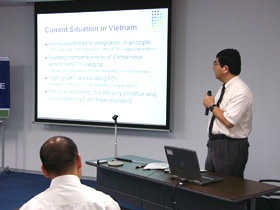 Prof.
Kenichi Ohno began his presentation by introducing VDF Hanoi and its
current activities, particularly VDFfs support for industrial strategy
formulation of the Ministry of Industry (MOI) of Vietnam. It was argued
that, although Vietnam was making impressive achievements such as high
economic growth and FDI acceleration, policy formulation still faced two
fundamental problems, i.e. poor business linkage and lack of
inter-ministerial coordination. Various examples were presented to
support this argument. He also pointed out some differences between
MOIfs common framework and VDFfs alternative ideas for drafting the
motorbike master plan, which VDF was currently assisting. Prof.
Kenichi Ohno began his presentation by introducing VDF Hanoi and its
current activities, particularly VDFfs support for industrial strategy
formulation of the Ministry of Industry (MOI) of Vietnam. It was argued
that, although Vietnam was making impressive achievements such as high
economic growth and FDI acceleration, policy formulation still faced two
fundamental problems, i.e. poor business linkage and lack of
inter-ministerial coordination. Various examples were presented to
support this argument. He also pointed out some differences between
MOIfs common framework and VDFfs alternative ideas for drafting the
motorbike master plan, which VDF was currently assisting.
Prof. Ohno
indicated three major ways forward for Vietnam: (i) greatly improve
marketing for FDI absorption without selectivity, (ii) strongly support
Vietnamese companies to establish business relations with FDI firms or
foreign buyers, and (iii) become a reliable partner of Japan by learning
integral manufacturing. Vietnam could also learn lessons from successes
and failures of industrial development policies in Thailand and
Malaysia, and Vietnam needed to take China into account when making
industrial policy. As a theoretical background, he presented the
business architecture framework of Prof. Takahiro Fujimoto (Tokyo Univ.)
which describes the difference between modular manufacturing and
integral manufacturing, and partnership possibilities among countries
with various architectural characteristics.
Prof. Ohno
showed some reasons why Vietnam and Japan could become fruitful partners
in integral manufacturing. According to him, Japan was an integral
manufacturing economy which had high technology, high wages, and rapidly
aging population. As highly skilled old labor force retire in droves
beginning in 2007, Japan needed a reliable developing country partner
with low wages, skilful labor force and young population. Vietnam--and
Thailand--could become such a partner of Japanese integral
manufacturing, once the above-mentioned fundamental policy problems were
resolved and the nation began to focus on attaining necessary
conditions. For this, two important requirements were industrial human
resources and supporting industries. These were actually intertwined.
General
discussion was started by Mr. Phan Chi Anh (YNU) with a question about
concrete examples of integral manufacturing. Prof. Ohno replied that the
automobile industry was a typical example as products were made of
model-specific parts in continuous adjustments among assemblers and part
producers, and a high-performing car in terms of style, power, balance,
fuel efficiency, comfort, etc. could not be made without such
interaction. He also pointed out that some countries tried to produce
cars with modular processes but with little success so far. In sharp
contrast, he noted that the computer industry was highly modular, in
which performance of assembled products was guaranteed by globally
common interface protocol among parts.
Mr. Pham
Truong Hoang (YNU & VDF Tokyo) asked Prof. Ohno to give additional
persuasive reasons, other than the ones already presented, for Vietnam
to become a partner of Japan. Prof. Ohno responded that modular
manufacturing might seem easy for Vietnam to follow at first, with low
initial requirements in time, money and technology, but that would be
the same for all developing countries. If Vietnam selected modular
manufacturing, it would face excess competition, low price and profit,
and no incentive or fund to upgrade technology, in a situation called
gtechnology lock-in.h Particularly, it would be very difficult to
compete directly with China, a gigantic modular manufacturer with ample
funds, reasonable technology, and a massive supply of unskilled labor.
Vietnam should avoid doing the same thing as China and look for niches.
He believed that learning integral manufacturing would be the key in
this. According to him, integral manufacturing would require patience
but help Vietnam to improve technology in the long run. Strong
commitments by both Vietnamese and Japanese governments, in close
cooperation with the business sector, were needed to realize this goal.
Being
concerned with technology transfers from Japan to Vietnam, Mr. Pham Viet
Duc (YNU) wondered whether Japanese firms would really transfer high
technology to Vietnamese firms when they became partners in integral
manufacturing. Prof. Ohno responded that technology transfer really
needed for Vietnam now was in the area of supporting industries such as
die-and-mold, pressing, casting, injection, etc. and not the so-called
ghigh technologyh such as biotech, nanotech or new materials. Our
expectation must be realistic since few Japanese firms would teach their
latest technology which had cost a lot of R&D money to others for free,
and since few Vietnamese firms were ready to absorb and use such
frontier technology. Prof. Ohno cited an example of FUTU1 Company in
Thai Nguyen Province that could produce high-quality key metal
components such as transmission gears for Japanese motorbike assemblers
in Vietnam. But it took FUTU1 for many years to upgrade quality with the
help of Yanmar at first, and later Honda. Through this integral
learning, its products became competitive. He reiterated that there
would be no future for Vietnamese firms if they just copied blueprints,
purchased cheap parts and components in the market, and assembled them.
Keynote Speaker 2:
Prof. David
O. Dapice (Tufts University & Vietnam Program, Harvard University)
gFear of Flying: Why is Sustaining Reform
So Hard in Vietnam?h
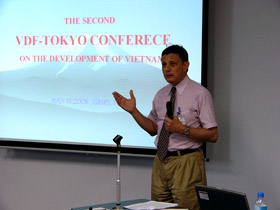 In the
second part of the morning session, we welcomed Prof. Dapice, who has
been doing research on Vietnam for a long time. He also teaches at the
Fulbright Economics Teaching Program (FETP) in Ho Chi Minh City. In the
second part of the morning session, we welcomed Prof. Dapice, who has
been doing research on Vietnam for a long time. He also teaches at the
Fulbright Economics Teaching Program (FETP) in Ho Chi Minh City.
His
presentation started with an overview of Vietnamfs achievements after 20
years of Doi moi. According to Prof. Dapice, Vietnam had been one
of the best-performing countries in the world to overcome numerous
difficulties and gain great successes in economic and social aspects,
such as high economic growth, substantial reduction of poverty, and
impressive international trade records. In his presentation, there were
four factors that contributed to those successes: (i) agricultural
reforms and market-based price reforms, (ii) the new Enterprise Law,
(iii) rapid and continuing growth of exports, particularly manufactured
exports, and (iv) high level of information available to citizens, in
the areas of free press and internet access.
However,
he agreed with Prof. Ohno that, in order to continue these successes
into the future and get better positioning in the global arena, Vietnam
should have strong and efficient institutions, which were lacking in
Vietnam in a number of areas. He additionally said that policy-making
processes in Vietnam could be analyzed by the well-known principal-agent
problem in economic theory. It meant that in some areas of the economy,
policy makers paid attention to maximizing their own interests, not
national interests, which in turn distorted their incentives and
behaviors.
Prof.
Dapice also gave some predictions on the Vietnamese economy in the next
20 years. First, exports would continue to grow, particularly when
Vietnam joined WTO, which was expected before the end of this year.
Second, there would be less concessional aid, reflecting the fact that
Vietnam would no longer be a low-income country. Third, Vietnam would
need more skilled labor, which depended on education system reform. He
underlined that what was important would be software, not hardware, in
renovating the education system in Vietnam. In other words, human
resources were extremely crucial, and the success or failure of Vietnam
would depend not on financial problems but on the attitude of people.
To show
the current weaknesses in policy making, Prof. Dapice gave a few
examples of wasteful public subsidies and investments in Vietnam. For
example, the recent consideration of building a new international
airport in Long Thanh, Dong Nai Province, was cited. According to his
analysis, it would be too difficult to achieve alleged goals, which was
to handle 80-100 million passengers a year and become a regional hub.
The new airport would also create serious problems of debt burden and
resource misallocation with a cost of about $4 billion or 10 percent of
GDP only for the first phase, and $8-$10 billion when completed. Another
example was government subsidies to Vinashin for securing shipbuilding
orders from abroad. According to his data, this would also be quite
wasteful. We must consider the fact that, in the gPost-WTOh period,
inefficient operation of state enterprises would become a serious
constraint on the economy and reduce Vietnamfs competitiveness. To deal
with these issues, his advice was to improve the quality of local
governments, which he called gbottom-up approachh. Provinces should
compete with each other in attracting FDI and domestic investment by
understanding the rules of global competition and upgrading business
environment.
Sharing
similar ideas with Prof. Ohno, he argued that Vietnam could grow at a
higher rate than it did if we coped thoroughly with these problems.
Decomposition of growth into various sources would help Vietnam know
what was going on, and what needed to be done in order to sustain high
growth. One of the most important factors that Prof. Dapice was
concerned with was the labor market, which was suffering from the
problem of brain drain, in which well-trained professional labor might
not be treated well due or given proper opportunities due to numerous
institutional constraints. He re-emphasized attitude of people as the
crucial factor, which might help to change the current situation.
To
conclude, Prof. Dapice mentioned some policy implications for better
achievements. He called for: (i) improvement in the financial market,
particularly the banking system, (ii) an efficient information system
for the business sector, and effective channels between business
associations and the government and, most important and challenging,
(iii) reform of the education system.
Q &
A for Prof. Kenichi Ohno & Prof. David Dapice
After two
keynote presentations, we had about 45 minutes for questions and
comments from participants.
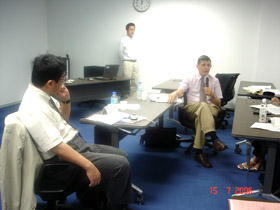 Mr. Luu
Hoai Son (GRIPS) asked Prof. Dapice to comment more on state investments
in Vietnam. According to him, although the state sector was conducting
about 75 percent of total investment, its rates of return were not high
as most of the investments focused on non-profitable projects such as
social infrastructure. In addition, Mr. Son said that some provinces
were better than others in attracting foreign investment, and that might
be due to their different perceptions of national goals. Prof. Dapice
admitted that there were some socially justifiable public projects, but
if we looked at state investments in general, we could see many projects
that invested in wrong places with wrong amount of money. Distinguishing
foreign and domestic investments, Prof. Dapice also stated that there
were some provinces that could attract large amounts of foreign
investment due to different characteristics, while domestic investment
had generally been limited because of various not-so-explicit
constraints imposed on them. This came from the policy of discouraging
glegal, but undesirableh investment projects. The authoritiesf attitude
on this needed to be changed. Mr. Luu
Hoai Son (GRIPS) asked Prof. Dapice to comment more on state investments
in Vietnam. According to him, although the state sector was conducting
about 75 percent of total investment, its rates of return were not high
as most of the investments focused on non-profitable projects such as
social infrastructure. In addition, Mr. Son said that some provinces
were better than others in attracting foreign investment, and that might
be due to their different perceptions of national goals. Prof. Dapice
admitted that there were some socially justifiable public projects, but
if we looked at state investments in general, we could see many projects
that invested in wrong places with wrong amount of money. Distinguishing
foreign and domestic investments, Prof. Dapice also stated that there
were some provinces that could attract large amounts of foreign
investment due to different characteristics, while domestic investment
had generally been limited because of various not-so-explicit
constraints imposed on them. This came from the policy of discouraging
glegal, but undesirableh investment projects. The authoritiesf attitude
on this needed to be changed.
Ms. Nguyen
Thi Thanh Hai (Waseda University) asked Prof. Dapice to clarify concrete
ways for Vietnam to continue to grow, and whether the ICT sector should
be prioritized in the future. She also asked Prof. Dapice about his
ideas on improving the educational system in Vietnam. Prof. Dapice
responded that the ways to sustain growth depended on sectors or areas,
and general prescription could not be given due to different
characteristics among them. He admitted that he did not have a concrete
answer on what sectors should be promoted, but he thought that markets,
especially investors, would know what needed to be done. He also said
that business sector and the government should cooperate in education
policy in order to provide needed human resources for prospective
sectors. He mentioned the Penang Skills Development Center in Malaysia
as a good case, in which multinational corporations coordinated with the
local government to decide what skills must be acquired by the workers,
and implemented appropriate training programs to supply them. Continuing
on the education policy, Prof. Dapice said that Vietnam should allow
non-profit and private universities to compete with each other to find
the best strategies for education and training. He gave an example of a
college in Quang Nam Province, which focused on training tourism-related
expertise in order to meet the increasing demand for tourism.
Prof. Ohno
remarked that two serious institutional problems in Vietnam, which were
also observed in other developing countries, were business-unfriendly
government and policies on the one hand, and the rigid labor market that
did not fully utilize existing talents, including professional people
educated abroad who did not wish to return to previous positions in
Vietnam. Additionally, Prof. Ohno said that we should work with not only
with local governments as Prof. David approached, but also the central
government in order to get better views of policy making. He pointed out
some projects that VDF was doing as examples for such approach.
Comparing
state and private sector development in Vietnam, Mr. Nguyen Duc Thanh
(GRIPS & VDF Tokyo) argued that, to promote private sector development,
the only thing to be done was simply to stop supporting state-owned
enterprises (SOEs). According to Prof. Ohno, however, such a view was a
little too simplistic; Vietnam should adopt a double-track approach of
promoting sound growth of private firms by introducing and enforcing
international standards and frameworks such as fair trade, transparent
books, pollution regulation, etc. on the one hand, and gradually
eliminating inefficient SOEs on the other--but not all SOEs needed to be
removed. Prof. Ohno thought that competitiveness mattered more than
ownership form. Prof. Dapice added that there would be another danger if
we stop supporting all SOEs now as it could create private monopoly,
which might also cause a dire situation as seen in some neighboring
countries. For him, serious restructuring and supervision of SOEs would
be the way to tackle the problem of inefficient SOEs and, more
importantly, improvements in the legal and financial systems would
contribute greatly to creating a level playing field among private
firms, and between private firms and SOEs. Agreeing with Prof. Ohno, he
said that there would be no once-for-all solution.
Mr. Pham
Viet Duc (YNU) raised a question to Prof. Ohno about concrete ways for
Vietnam to become a reliable partner of Japan in integral manufacturing.
Prof. Ohno responded that, to know what needed to be done, in general,
Vietnamese firms should listen to foreign firms attentively. With
Japanese firms, Vietnamese firms should understand their business
philosophy, including the value of trust, long-term relationship, and
various systems to ensure QCD (Quality-Cost-Delivery). If Vietnamese
firms did so and made effort to become integral manufacturing partners,
FDI would help them to export their products indirectly to the global
market, as components of their final products. These points must be
understood fully by policy makers as well. VDF was already working to
fill the information gap between Japanese FDI firms and Vietnamese
businesses and authorities through conducting a Japanese firm survey and
publishing reports.
Continuing
with the partnership issue, Mr. Phan Chi Anh (YNU) asked about the
commitment on the Japanese side to help Vietnam to become its reliable
partner. In his response, Prof. Ohno said that commitments from both
sides were crucial, and VDF would strive to ensure that both sides would
cooperate. He pointed to some ongoing cooperation between Japanese and
local firms in the neighboring countries, for example, to encourage
Japanese SMEs with high skills to invest in Thailand or upgrade
die-and-mold industries in Indonesia. Prof. Dapice also added that
Vietnam was absorbing investment from a large number of source
countries, and could choose the best combination of sources, not only
from Japan, for capital, knowledge, and technology. Moreover, when
Vietnam learned certain skills and knowledge from those sources, it
could do very well in the global economy. Choosing partners through
understanding each otherfs requirements, as Prof. Ohno suggested, would
call for strong interests of both sides, and it would be a good way too.
Going back
Prof. Dapicefs presentation, Mr. Pham Truong Hoang (YNU & VDF Tokyo)
wanted to hear more about the educational system in Vietnam as it seemed
to Mr. Hoang that academic and practical knowledge of the developed
world might not be applicable to Vietnam right now. He said that Vietnam
was roughly in the same development stage as Taiwan in the 1970s, when a
large supply of highly skilled workers was not yet needed. Ms. Pham
Quynh Huong (University of Tokyo) echoed and said that it was difficult
to apply knowledge from abroad to Vietnam directly, as Mr. Hoang
mentioned, and acquired skills generally did not meet the demand of the
Vietnamese economy. She wondered how institutions in Vietnam could be
re-designed to encourage skills that were actually demanded, and also
how top-class universities could be created in Vietnam despite the fact
that no Vietnamese universities were ranked highly at present. In reply,
Prof. Dapice said that incentives for excellence were low in the
Vietnamese education system as professors received low salaries and were
bound by curriculums and other rules imposed by the university or the
Ministry of Education and Training. Since the global economy was
changing fast, and since Vietnam was attracting a large volume of FDI,
demand for skilled labor would surely rise in the future. As for
top-class universities in Vietnam, Prof. Dapice said that there should
be not only one good university, but a system of educational
institutions that together could achieve global standards. He strongly
felt that Vietnam needed to introduce a voucher system, in which
students could choose universities and professors which best suited
their demand. This would create competition and incentive for doing
better in higher education. Local governments should also work
effectively with industries so that demand for needed skills would be
realized. In other words, Vietnam should use the power of consumers to
reform education.
@
@
Afternoon Session:
Presentations
ECONOMICS AND BUSINESS SESSION
(Room 4A)
The
Economics and Business Session was chaired by Prof. Kenichi Ohno. The
first presentation was by Mr. Le Anh Minh of Nagoya University. The
second was by Mr. Vu Thanh Tu Anh from the Fulbright Economics Teaching
Program (FETP) in HCMC. Mr. Phan Chi Anh of Yokohama National University
(YNU) was the last presenter of the session.
Presentation 1: Mr. Le Anh Minh (Nagoya University)
gMacroeconomic Policy Analysis of Vietnam: A Macroeconometric
Model Approachh
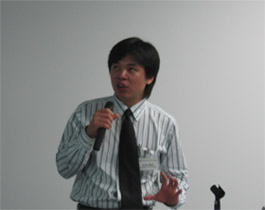 The
objective of this research was to analyze the impacts of macroeconomic
policy on the Vietnamese economy in the transition period. The
presentation began with an overview of the Vietnamese economic
performance and economic policy tools after the implementation of the
Doi moi process. He showed that, in order to stabilize the economy
at the beginning of transition, both tight fiscal and monetary policies
were adopted. Caution was exercised in conducting exchange rate policy,
which allowed VND to devalue modestly and gradually. A brief description
of the economyfs progress during the period 1986-2003 was presented. The
objective of this research was to analyze the impacts of macroeconomic
policy on the Vietnamese economy in the transition period. The
presentation began with an overview of the Vietnamese economic
performance and economic policy tools after the implementation of the
Doi moi process. He showed that, in order to stabilize the economy
at the beginning of transition, both tight fiscal and monetary policies
were adopted. Caution was exercised in conducting exchange rate policy,
which allowed VND to devalue modestly and gradually. A brief description
of the economyfs progress during the period 1986-2003 was presented.
The author
proceeded to the major part of his presentation which showed a
macro-econometric model of Vietnam. Data employed in his model were
annual macro data collected from various sources, and Eview 4.0 was the
software used. Due to the limited number of observations, Seemingly
Unrelated (SUR) estimation technique was adopted. This approach allowed
the author to at first estimate seven single equations, which reflected
major macro behaviors of the economy. The SUR model was then applied to
estimate a system of equations. To illustrate the prediction capacity of
the model, two concrete cases were mentioned. The first was to estimate
effects of a fiscal expansion policy, where government investment was
assumed to increase by 5%. In this case, there would be 0.31% increase
in output and almost 2% increase in investment of domestic firms, while
the price level would rise slightly. The second simulation was a 5%
devaluation of VND, in which output was predicted to increase by 0.27%
while the price level would raise about 4.5%.
Mr. Nguyen
Duc Thanh (GRIPS & VDF Tokyo) started free discussion by taking issues
with the authorfs view that the Vietnamese economy slowed down after the
Asian financial crisis. Mr. Thanh argued that in reality the economy
already shown signs of slowdown in 1996, one year before the crisis, and
emphasized that it was supply side factors which influenced the economy
at that time. Mr. Minh explained that he was concerned with the
demand-side effect of the crisis, and believed that the crisis led to a
significant reduction in foreign investment at that time. Prof. David
Dapice shared a view that both supply and demand sides affected the
economy at that moment. Concerning the first simulation results from the
research, Ms. Bui Thi Thu (Hitotsubashi University) questioned its
meaning. She was cautious about a policy of increasing governmentfs
investment and its expected consequences. Mr. Pham Viet Duc (YNU) said
that a large amount of remittances flowed into the economy recently, and
asked whether the model captured this fact. Mr. Tran Duy Dong
(Hitotsubashi University) discussed some ways to improve the empirical
works of this research.
Presentation 2: Mr. Vu Thanh Tu Anh (FETP, HCMC)
gCompetition and Privatization in Vietnam: Substitutes or
Complements?h
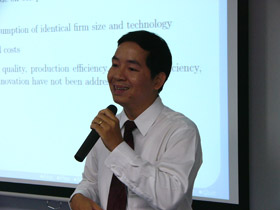 The
second presentation was by Dr. Vu Thanh Tu Anh. His paper explored the
relationship between privatization and competition policies in the
governmentfs policy mix in a transition economy. The
second presentation was by Dr. Vu Thanh Tu Anh. His paper explored the
relationship between privatization and competition policies in the
governmentfs policy mix in a transition economy.
The
author explained the current debate in identifying the relationship
between the two policies, both of which were essential in transforming a
central planned economy to a market-oriented one. There was so far no
clear-cut conclusion whether these policies were substitutable or
complementary. He also reviewed the process of introducing privatization
and competition in Vietnam. Privatization had undergone at least two
different stages, while competition pressure continuously evolved with
the recent approval of the Competition Law as a landmark.
To analyze
the problem, the author introduced a model based on the Dixit-Stiglitz
model of monopolistic competition. In terms of ownership the marginal
cost of production of private firms was assumed to be lower than that of
SOEs (due to the inherent inefficiency of the latter), while the fixed
cost of the former was higher than the latter (due to asymmetric
treatment of the two sectors). Competition policy was assumed, by the
intention of the government, to reduce the gaps between both marginal
and fixed costs of the two sectors. The results heavily depended on the
type of government, or on the real objective behind governmentfs action.
The model was able to point out that a rent-seeking government would not
be willing to privatize profitable SOEs, and tend to increase the costs
of private firms, whereas a benevolent government would treat two
sectors equally and tend to privatize all the SOEs. In the latter case,
privatization and competition polices were certainly complementary.
In the
discussion section, Mr. Pham Viet Duc (YNU) asked about the Competition
Law in Vietnam and its real enforcement. Some other participants argued
that the concept of gefficiencyh - an important term used throughout
this research - could be defined from different aspects such as output,
productivity or welfare.
Presentation 3: Mr. Phan Chi Anh (Yokohama National
University)
gQuality Management and Competitive Performance: An Empirical Evidence
of Impact of ISO 9000 in Vietnamese Manufacturing Companiesh
(with
Prof. Yoshiki Matsui, International School of Social Sciences, Yokohama
National University)
In his
turn, Mr. Phan Chi Anh presented his paper co-authored with Prof.
Yoshiki Matsui, who was also present.
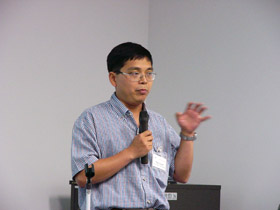 ISO 9000
quality management system (QMS) standard was established in 1987 and had
been quickly popularized worldwide, in spite of its implementation
costs. In Vietnam, ISO 9000 implementation had been strengthened since
1995. The current study aimed to explore the relationship between ISO
9000 QMS and business performance in the Vietnamese manufacturing
companies. Mr. Anh also gave an analysis of benefits as well as
difficulties in implementing ISO 9000. For these, the authors conducted
a survey on 125 ISO 9000-certified Vietnamese manufacturing companies in
2003-2004. The research showed that companies highly appreciated the
benefits of ISO 9000, particularly in leveling up gWork Procedureh and
gResponsibility and Authority.h There were, however, also many
difficulties in implementing ISO 9000, in which gMaintain Incoming
Qualityh and gControl Non-conformitiesh would be the most difficult. The
authors also used the results from another survey on 38 Vietnamese
manufacturing companies with 116 respondents of the firmsf managers was
carried out in 2005-2006 in order to investigate the impacts of ISO 9000
on business performance. The regression results indicated strong impact
of ISO 9000 on internal business process performance, moderate impact on
customer and market performance and finance performance, and little
impact on development, learning and innovation performance. It was
recommended that future methods of quality management in manufacturing
firms in Vietnam should be ISO 9000 plus other methods such as 5S,
Kaizen, or QC 7 tools. The authors also suggested a necessity of linking
QMS with other systems such as human resource management, Just-in-time,
and technology development and Information management. ISO 9000
quality management system (QMS) standard was established in 1987 and had
been quickly popularized worldwide, in spite of its implementation
costs. In Vietnam, ISO 9000 implementation had been strengthened since
1995. The current study aimed to explore the relationship between ISO
9000 QMS and business performance in the Vietnamese manufacturing
companies. Mr. Anh also gave an analysis of benefits as well as
difficulties in implementing ISO 9000. For these, the authors conducted
a survey on 125 ISO 9000-certified Vietnamese manufacturing companies in
2003-2004. The research showed that companies highly appreciated the
benefits of ISO 9000, particularly in leveling up gWork Procedureh and
gResponsibility and Authority.h There were, however, also many
difficulties in implementing ISO 9000, in which gMaintain Incoming
Qualityh and gControl Non-conformitiesh would be the most difficult. The
authors also used the results from another survey on 38 Vietnamese
manufacturing companies with 116 respondents of the firmsf managers was
carried out in 2005-2006 in order to investigate the impacts of ISO 9000
on business performance. The regression results indicated strong impact
of ISO 9000 on internal business process performance, moderate impact on
customer and market performance and finance performance, and little
impact on development, learning and innovation performance. It was
recommended that future methods of quality management in manufacturing
firms in Vietnam should be ISO 9000 plus other methods such as 5S,
Kaizen, or QC 7 tools. The authors also suggested a necessity of linking
QMS with other systems such as human resource management, Just-in-time,
and technology development and Information management.
Several
questions and comments were raised by participants. The first comment
was on the sample size. According to Prof. Ohno and Dr. Hasashi Kono
(Institute of Developing Economies), 38 samples for 3 industries (i.e.
transportation, mechanical-machinery, and electrical-electronic) were
too small. Prof. Ohno and Prof. Dapice also considered that the
questionnaire was not sufficient to identify causal relationships from
ISO acquisition to performance, or vice versa. Therefore, the results
should be interpreted as showing only correlation between ISO and firm
performance. Prof. Ohno additionally said that ISO might be used mainly
as an advertising tool. This point was also shared by Dr. Kono (IDE) and
Mr. Junichi Mori (VDF Tokyo). To have better understanding of cause and
effect, Prof. Ohno suggested a comparative study about firm performance
before and after ISO 9000 implementation. Mr. Le Anh Minh (Nagoya
University) wondered if the modelfs fit was too low with R-squared of
60-70%. Prof. Dapice asked about implications of the findings for
companies. Mr. Nguyen Viet Ha (Panasonic Mobile Communications) was
skeptical about the firmsf ability for dynamic innovation when workers
were constrained by excessive regulations of ISO 9000. Mr. Pham Truong
Hoang (YNU & VDF Tokyo) recommended that ISO 9000 could be considered as
ghardwareh for quality management. The long-term efficiency of quality
management also relied on gsoftware,h which could be understood as
workersf attitude and behavior.
Regarding
the small sample size, Mr. Anh admitted that the research budget did not
allow to expand the sample size. According to his interviews with
managers, there were many reasons for firms to implement ISO 9000, and
advertising was certainly one of them. He also indicated that, before
the implementation of ISO 9000, firms had neither a system of quality
management or related documents. That fact prevented a comparative study
about quality-related performances before and after the implementation
of ISO 9000. On the fit of the regression model, he responded that
R-squared in the paper was not bad if we compared it with other studies,
which had similar sample sizes but R-squared was sometimes lower than
30%. For the implications of the results, Mr. Anh stated that the
findings could be useful for private companies which were building their
manufacturing capabilities. With regards to the role of ISO 9000, he
emphasized the positive impacts of ISO 9000 on firmsf process
management, which in turn might lead to quality improvement. This point
was also supported by Mr. Mori and Mr. Hoang.
@
SOCIAL ISSUES SESSION
(Room 4B)
The Social
Issues Session was chaired by Prof. Izumi Ohno. The session welcomed
Prof. Wade Pfau from GRIPS as the first presenter. The second presenter
was Mr. Tadashi Kikuchi, Lecturer of Keio University. The last presenter
was Ms. Aiko Takai, a newly-graduated student of University of
Amsterdam, the Netherlands.
Presentation 1: Associate Prof. Wade Pfau (GRIPS)
hLiving Arrangements of the Vietnamese Elderly during
Economic Transitionh
(with Giang Thanh Long)
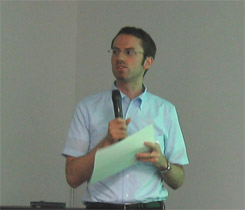 Prof. Wade
Pfau (GRIPS) presented his research with Mr. Giang Thanh Long (GRIPS &
VDF Tokyo) on the living arrangements of the Vietnamese elderly during
economic transformation, which was based on four Vietnam (Household)
Living Standard Surveys. Motivation for
doing this research was related to the interest in non-contributory
pension scheme for the elderly people, which required information on the
current status of the elderly. He focused on two out of six listed major
issues in the presentation, i.e. living arrangements and poverty status
of the elderly people. Prof. Wade
Pfau (GRIPS) presented his research with Mr. Giang Thanh Long (GRIPS &
VDF Tokyo) on the living arrangements of the Vietnamese elderly during
economic transformation, which was based on four Vietnam (Household)
Living Standard Surveys. Motivation for
doing this research was related to the interest in non-contributory
pension scheme for the elderly people, which required information on the
current status of the elderly. He focused on two out of six listed major
issues in the presentation, i.e. living arrangements and poverty status
of the elderly people.
In the
first part of presentation, Prof. Pfau reviewed existing literature on
living arrangements of the elderly in Vietnam and some other regional
countries. Although the existing studies used different datasets and
surveys, they found very similar results of living arrangements of the
elderly in Vietnam such as they had preference of living with married
sons, which was the same as Chinese counterparts. However, the current
research could further classify the elderly with different positions
within the household, and obtain more information about poverty status
of the elderly. The advantages and limitations of the current dataset
were explained. Surveys used provided comprehensive data on various
aspects of living arrangements that were useful for research. At the
same time, some interesting indicators such as relatives in household
were not contained.
The
results from estimation showed that Vietnamese population was aging
modestly, as seen by an increasing percentage of the elderly, and the
number of living-alone elderly was increasing over time. One interesting
finding was that the elderly as defined to be 60 and over might be too
young. The age threshold should be higher since people at 55-60 and
60-65 had the lowest poverty rates, as well as high labor force
participation rates. In term of living arrangements, the results also
indicated that familial relations in Vietnam were still strong, despite
fast social and economic changes. The elderly were not simply
dependents; they were often active contributors to household income.
However, one of the emerging issues was that benefits from social
welfare programs such as pension accounted for a small part of elderly
householdfs income, and the elderly relied mostly on other sources. This
fact indicated that the elderly might face difficulties once they could
not get any support from family. Policy implication was that an
efficient social safety net must be in place in order to help the
elderly in dire situations.
The
discussion was begun by Prof. Masahira Anesaki (Daiichi Welfare
University) who asked about the influence of Confucianism in Vietnamese
families. In addition, Prof. Anesaki also suggested the authors to
divide the elderly into different age subgroups to get more information.
For instance, people aged from 60 to 65 could be defined as young
elderly, and then 65-75 and 75+ could be classified as older elderly,
and oldest elderly, respectively. As for the first question, Mr. Long
admitted that the study did not consider Confucianism directly, but he
personally thought that Confucianism was stronger in the North than in
the South, which could be explained by the fact that the North was more
heavily influenced by Chinese culture. For the second comment, both
authors thanked Prof. Anesaki for his idea, and they thought that it
would be useful for their research on poverty and gender issues of the
Vietnamese elderly.
Ms. Aiko
Takai (from Nagoya City) wondered whether influences of Confucianism
depended upon the social classes. Mr. Long again confirmed that the
topic was not covered in the presentation, and he would like to talk
with researchers who were specialized in the field, in order to get
precise responses.
Dr.
Hisashi Kono (Institute of Developing Economies) said that there were
many migrant workers in big cities like Hanoi and HCMC, and most of them
were young and elderly women. He wondered if these people were covered
in the research. Moreover, he also wanted to know more clearly about the
definition of familial relations, and whether remittances could become
an indicator of relations. In response to the first question, Mr. Long
said that the authors used V(H)LSS data to study the elderly, and thus
the elderly mentioned by Dr. Kono were not in the sample, and they would
need to have another survey for such elderly. For the second question,
Prof. Pfau said that the current research treated remittances separately
from familial relations, and the latter was proxied by household living
arrangements. He additionally said that remittances would be a good
topic for further study, and they would conduct another research with
some regression models for that purpose. Mr. Vu Tuan Khai (YNU) agreed
with that response.
From
University of Tokyo, Ms. Sakuya Nose said that she was interested in the
pension scheme in Vietnam, and she would be glad if the authors could
provide some information. Mr. Long responded that VDF had one discussion
paper on the pension scheme of Vietnam, which could be a reference for
her. However, he also added that the current pension scheme in Vietnam
covered a small part of population as well as the elderly, and therefore
social insurance had to be expended and made more effective.
Presentation 2: Mr. Tadashi Kikuchi (Lecturer, Keio
University)
hSeeking Effective Performance, Minimum Cost, and Good
Official Development Assistance (ODA) Performance Evaluation: A Case
Study of Bach Mai Hospital, Vietnamh
In his
presentation, Mr. Kikuchi tried to answer a series of questions: Do
donors really enjoy providing ODA? Can Vietnam receive a large amount of
ODA in the future? Why does the Millennium Development Goals (MDGs) not
mention GNP? Which economic actors play the main role for development?
Who benefits from ODA?
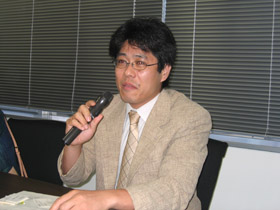 Development strategies in the past and future, and the main contents of
MDGs, were briefly reviewed. Then, relationship among economic growth,
nourishment, and aid dependency in the world was explained. Using the
data from World Development Indicators (WDI) 2003, the author showed the
negative correlation between GDP growth and ODA dependency, and the
positive relationship between the under-nutrition ratio to GDP and ODA
dependency for four main developing regions, i.e. Eastern Europe,
Central Asia, East Asia and the Pacific, and the Middle East and North
Africa. Based on two indicators of the under-nutrition ratio to GDP and
economic growth, he classified the above four regions and compared their
characteristics. Development strategies in the past and future, and the main contents of
MDGs, were briefly reviewed. Then, relationship among economic growth,
nourishment, and aid dependency in the world was explained. Using the
data from World Development Indicators (WDI) 2003, the author showed the
negative correlation between GDP growth and ODA dependency, and the
positive relationship between the under-nutrition ratio to GDP and ODA
dependency for four main developing regions, i.e. Eastern Europe,
Central Asia, East Asia and the Pacific, and the Middle East and North
Africa. Based on two indicators of the under-nutrition ratio to GDP and
economic growth, he classified the above four regions and compared their
characteristics.
Mr.
Kikuchi moved on to the case of Vietnam, in which he showed that Vietnam
was an outlier in the world in the sense that its GDP grew very fast in
the 1990s in comparison with its nutrition condition. In other words, he
argued that the nutrition condition in Vietnam did not improve as much
as economic growth. He then raised the question of how to narrow that
gap, and what strategies of ODA would be suitable for Vietnam. Finally,
the case study of Bach Mai Hospital was presented, in which a
staff-training project of Japan International Cooperation Agency (JICA)
took place. From the descriptive statistics, the author hypothesized
that the educational cost per additional trainee might decrease as the
knowledge of managers was transferred to other counterparts and junior
staff through face-to-face learning in the training course. He tested
this hypothesis by using an econometric method. He concluded that the
ratio of staff to managers was one of the tools to check the extent of
improvement of project performance, and ODA projects should be require
the leader to perform his or her role efficiently.
In
discussion, Prof. Masahira Anesaki (Daiichi Welfare University) raised
the case of Japanfs ODA in the Caribbean countries, in which many
wasteful incidents were observed (e.g. toilets were built with
anti-earthquake specification like in Japan, in places where there were
no earthquakes) due to the lack of careful cost and design
considerations. He asked why the author chose the factor of leadership
in his study, but not such factors as cost or design. Mr. Kikuchi
responded that leadership was the topic he wanted to investigate, but
other factors could also influence the result. Mr. Giang Thanh Long
(GRIPS & VDF Tokyo) pointed out some typos, and commented that the
organization of his paper was somewhat difficult to follow, e.g. what
was the linkage between the nutrition level and SARS. There were also
comments from Prof. Pfau (GRIPS) and Dr. Kono (IDE) that the
relationship between GDP growth and the ratio of under-nutrition to GDP
might not be linear as assumed by the author, and the author should be
more careful in causality and scale effect problems. Mr. Kikuchi
admitted to these problems, and said that he would consider them in the
next step of the study. At the end, Prof. Izumi Ohno commented on the
presented data and said the situation in some regions outside East Asia,
with high aid-dependency and low economic growth, could suggest some
causes as well as policy implications for ODA that needed to be studied
more thoroughly.
Mr.
Kikuchi thanked all participants for their comments and suggestions. He
would like to exchange results again with them after revising the study.
Presentation 3: Ms. Aiko Takai (University of Amsterdam)
hBetween Nurturing and Nurtured Childhood: Children Working
on the Streets in Hanoih
Being
interested in children working on the streets in Hanoi, Ms. Aiko Takai
from Nagoya shared information on the issue and exchanged views with the
participants. Her presentation was based on her completed Master Thesis
at the University of Amsterdam, the Netherlands.
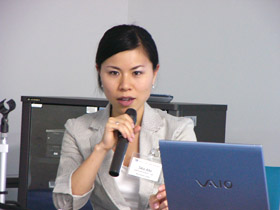 Ms. Takai
began with the background of her study. She wanted to understand the
widening gap between nurtured and nurturing childhood of children under
globalization, and how they were reinforced by greinventedh Confucian
tradition. Then, she reviewed definitions by international organizations
such as UNICEF. She also described data and methodology. She had
face-to-face interviews with 15 children working in the streets in
Hanoi. Ms. Takai
began with the background of her study. She wanted to understand the
widening gap between nurtured and nurturing childhood of children under
globalization, and how they were reinforced by greinventedh Confucian
tradition. Then, she reviewed definitions by international organizations
such as UNICEF. She also described data and methodology. She had
face-to-face interviews with 15 children working in the streets in
Hanoi.
The first
part of the results compared the real lives of rich and poor children
through some indicators such as physical appearance and expected role as
workers or learners. There were significant differences between nurtured
(rich) and nurturing (poor) children. For instance, the rich children
were not producers but consumers, while the poor children experienced
gpovertyh from the early age, and they brought most earnings to support
the family. The second part focused on the role Confucian tradition and
explored tensions that nurturing and nurtured children were facing. The
analysis from the authorfs interviews showed three major tensions for
the nurturing children, i.e. government policies to the children working
on the streets, their parentsf expectations, and tension with rich
children. The analysis showed that the reinvented Confucianism oppressed
poor children and prevented them from having unrealistic or unattainable
dreams.
To
conclude, Ms. Takai emphasized that gstreet childrenh was a label, which
was wrongly equated with a social phenomenon, and childhood was
different from one to one. Under social and economic tension, they
needed to be protected, and the socio-cultural background in creating
working children on the streets also needed to be considered.
Prof.
Masahira Anesaki (Daiichi Welfare University) started the discussion by
asking Ms. Aiko to provide definition of gstreet childrenh as he could
observe many kinds of children working in the streets. In her response,
Ms. Takai said that she did not use the term gstreet childrenh in her
research because it might be misleading; instead, she used the term
gchildren working in the streetsh as it could reflect more closely to
the ones in her interviews. However, she thanked Prof. Anesaki for his
comment, and said that she would explore more definitions in her future
research.
In
addition, Prof. Anesaki shared his information about ethnic minority
working children that he met in Vietnam, and he wondered what would
happen to them. Ms. Takai said that she also met such children, but they
were not in her research, and it would be good to take them into account
for a deeper analysis.
From VDF
Hanoi, Ms. Duong Kim Hong sent comments and questions about the
presentation to Ms. Takai. According to her comments, there was a
variety of reasons that children had to work, and one of them was that
their families were too poor. Contrarily, some children liked to work,
even though they were not responsible for supporting their families.
Therefore, it might be difficult to use Confucian tradition to explain
about children working in the streets. In addition, Ms. Hong would like
to know the definition of grichh and gpoorh children that Ms. Takai
mentioned in the presentation. In her reply, Ms. Takai said that there
would be some limitations from the research as the number of interviewed
children was too small, and what she mentioned in the presentation was
from broader analysis, which was partly based on those interviews. She
also said that she would discover other aspects so that we could
understand more about their lives and hidden stories. She would like to
work more with VDF on the issue since VDF already had one publication,
which was closely related to her research interest.
Mr. Giang
Thanh Long (GRIPS & VDF Tokyo) provided some comments and information
related to Ms. Takaifs presentation. Additionally to the question by Ms.
Hong, he asked about the localities that the interviewed children came
from and worked because that was one factor that influenced why and how
they worked on the street. He also said that, based on previous studies
including VDFfs, street children working in different regions, e.g.
Hanoi and HCMC, would have different consumption behaviors, and thus
their support to family also varied. Studying why they worked in certain
location might help to explore the nature of economic tension. Ms. Takai
said that information was again lacking due to the small sample, and
most of the interviewed children were from northern provinces and could
not be generalized to the entire country. She thought that it would be
useful to have interview results with children from HCMC as well.
As a
visiting research fellow at GRIPS Development Forum (GDF), Ms. Chikako
Oka (London School of Economics and Political Science) raised a question
about a possible contradiction between reinvented Confucian thought and
the wish of children to get involved in business as Ms. Takai found in
her interviews. Moreover, she wanted to see comparative studies on
Confucian thought among countries if possible. Ms. Takai replied that,
to the best of her knowledge, there were only a limited number of
research on street children that focused on Confucian thought, and there
might be no comparative studies on the issue. To illustrate a wish to
start a business among street children, she gave an example from her
interviews, where a boy wanted to get business for numerous reasons,
including his social status in peoplefs eyes. However, she also admitted
that it would be difficult to have concrete conclusion from such a small
sample.
Being
interested in this social issue in Vietnam, Mr. Hoang Van Phuong (Hitotsubashi
University) commented that the Vietnamese government provided various
supports to street children and their families such as free tuition
fees. Those supports, however, could not solve the problem completely,
particularly in the rural areas due to severe poverty. He would like to
know Ms. Takaifs ideas about policy. Ms. Takai agreed that school
supports would be helpful, but children and their families must pay much
money for continuing to go to school such as buying books. Children
often had to drop out to help their family. She said that it was
difficult to prescribe perfect policies to deal with the problem, and it
also required coordination among many organizations.
At the end
of the presentation, Ms. Takai thanked all the participants for useful
comments, and she would be glad if participants could send her more
comments. She also planned to work with VDF on the issue. @
Some More Photos
@
TOP |